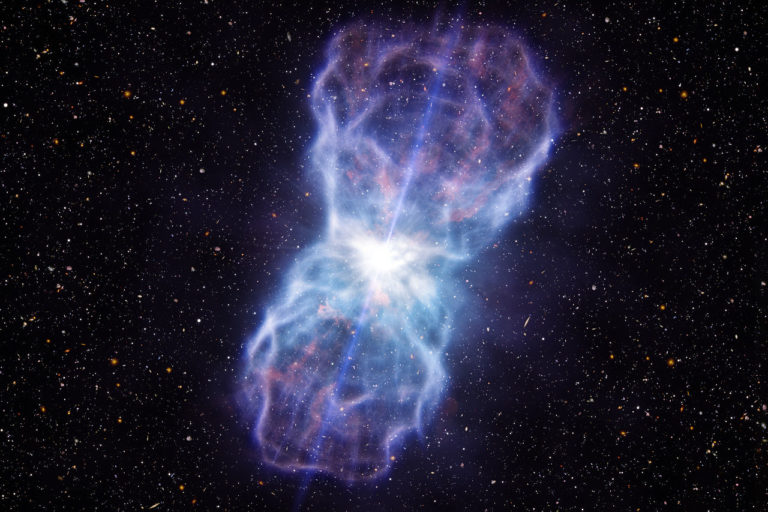A new census of the brightest cosmic objects brings us closer to solving the mystery of some of them seem to disappear
It is the greatest disappearance event in the universe. False stars (Quasars) – illuminated beacons powered by enormous black holes glittering in the heart of distant galaxies – have been observed disappearing, sometimes fading away in less than a year. After that, ordinary and standard galaxies appear in this diminished glow. Although astronomers have known for a long time that any pseudo star will eventually become dormant, since its central black hole completely depletes its raw materials of gas and dust, these bodies are so huge in size that even this process will inevitably take tens of thousands of The years. So how can this happen in less than a year?
There is a suggestion that dust clouds passing in front of fake stars may have temporarily blocked them from seeing. Some theorists have argued that these strange objects may have been quite another thing: when a massive black hole devours a star, it can cause a bright, sufficiently brief burst. Or perhaps a passing sun can play the role of a celestial magnifying glass, causing the light to amplify the glare. But most of these ideas are left out, and instead, astronomers say the evidence suggests that the pseudo-stars themselves are changing. Specifically, the real reason is some of the changes in its cumulative interstellar disk, the ring of hot matter that surrounds the black hole feeding. Now, this theory is supported by a new study in its preliminary version, recently approved for publication in the journal Proceedings of the National Academy of Sciences USA . Astronomer Matthew Graham and his colleagues at the California Institute of Technology doubled the number of “variable appearance” pseudo-stars by nearly three times – all showing clear changes in their cumulative stellar disk. This is the largest sample of pseudo-stars ever collected, and it has allowed astronomers to finally peek at deeper details behind these mysterious changes, which in turn may help to come up with better explanations for the mechanisms of feeding black holes and the ways in which galaxies such as the Milky Way are developing. Through cosmic time.
Since the discovery of the first known faux-star known in 2014, astronomers have been carefully searching for more of these strange objects, some of which seemed to shine rapidly as one of the galaxies suddenly glowed into a luminous faux star. The timescale also seemed impossible in this case. Therefore, astronomers observed these bodies at all available wavelengths. More recently, this approach has included both visible light and infrared light – two wavelengths that allow researchers to explore different aspects of the physical system. In a pseudo star, visible light often emits from the cumulative astral disc, while infrared light comes primarily from a larger, remote hoop from the center, which is a donut-like ring, formed by dust that encircles the cumulative astral disc. These two overlapping observations revealed striking new details: the observed changes in the visible light range are offset by changes in infrared light. Since the bright cumulative stellar disk emits light toward the darker hoop, where it is absorbed and relaunched as infrared wavelengths, this simulation is considered as conclusive evidence that some kind of rapid change occurs within the cumulative stellar disk itself. Nicholas Ross, co-author of the new study and astronomer at the University of Edinburgh, Scotland, says: “I bet with a large amount – perhaps not up to my mortgage or loan amounts for my students – that changes in the rate of pure accretion are a likely explanation.”
In light of this model, Graham, Ross and their colleagues carefully reviewed data from the Catalina Sky Survey project, which includes measurements of a decade-long optical curves (measurements of light brightness as a temporal function) from about half a billion sources across the sky. First: The team examined Catalina data in order to find pseudo-starred objects based on their spectra (various colors of their emitting lights). Second, the team analyzed the visible-light curves to determine the pseudo-stars that were darkened over time, and compared them to the infrared-light curves (using data from the NASA’s Wide-Field Infrared Survey Explorer) to see how darkness occurred for each A crime across both types of light. Finally, the researchers studied the spectrum released by each object after being darkened again to ensure that the orb turned into a galaxy. Then they looked for galaxies that turned into fake stars.
Altogether, the team discovered 111 rapidly changing fake stars, adding to about 60 stars already known. But the matter went beyond simply adding entries to an index, as the new study constitutes a solid, realistic test of an emerging model of the physical conditions responsible for this enigmatic phenomenon. This accomplishment makes her a milestone on the road, says Eric Morgansson, astronomer at the University of Illinois at Urbana-Champaign who has not participated in the study. And all of the new oddities in astronomy – even the same pseudo-stars discovered in the mid-twentieth century – entered the field for the first time through “dazzling” research that mainly indicated their alienation. Astronomers begin with a few examples that leave them confused. But as they seek and search for more in a systematic way, they also gain a deeper understanding, to create better models of what they think is really happening. Finally, scientific research begins a new phase, with observations often revising just existing models rather than creating entirely new models. Morganson says this study marks a turning point.
In the new specimen, each specific pseudo star initially showed a change in the visible light range, followed by a change in the infrared light range. This is sufficient evidence, according to the authors of the research, to conclude that the observed change is inherent in the pseudo star itself, and not as a result of an external event or force. Hence, the team finds that, instead of describing these pseudo-stars as “variable in appearance”, it is better to be described as “variable in state” to reflect the true nature of their origins.
Leaving aside scientific terms, the essence of the puzzle remains: how exactly can an entire pseudo-star be suddenly dimmed? And how, exactly, can a galaxy suddenly shine? Researchers prefer an explanation that refers to changes in the cumulative stellar disk temperature – due to cold or hot gas fronts , transformed magnetic fields, or a mixture of both. Regardless of the root cause, their study set an example of what the cumulative interstellar disk would look like in order for such changes to circulate very quickly. Specifically, the team discovered that the disc must be very thick and sticky for such rapid changes to appear. Kathleen E. says. “You can send a wave through molasses faster than water,” said Savic Ford, astronomer at the American Museum of Natural History (AMNH) in New York City and the Community College of Manhattan (BMCC) at New York City University. The same goes for a thicker, puffy disc – something like donuts like a CD. “You can think of it like a tube,” said Safik Ford. “It can transfer information through a thick tube faster than it is transferred through a thin tube.” So, regardless of what the change is, it will likely require a swollen and sticky disc.
This conclusion contradicts the long-held consensus scientific opinion, that such discs must be thin. However, Barry McKiernan – co-author and astronomer at the American Museum of Natural History in New York City and the Community College of Manhattan at New York City University – says the result is consistent with recent theories suggesting that cumulative stellar disks may be very thick.




